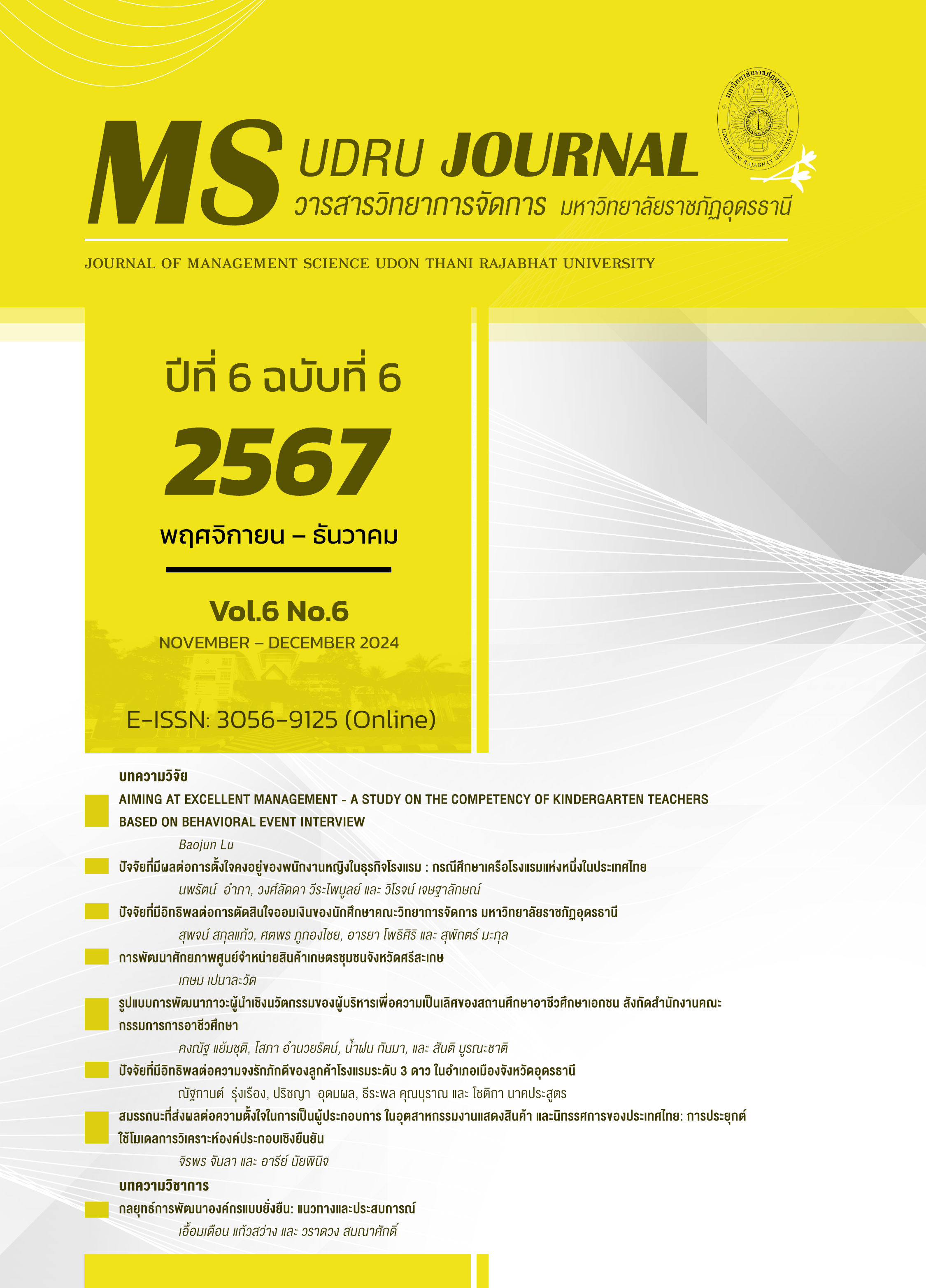สมรรถนะที่ส่งผลต่อความตั้งใจในการเป็นผู้ประกอบการ ในอุตสาหกรรมงานแสดงสินค้า และนิทรรศการของประเทศไทย: การประยุกต์ใช้โมเดลการวิเคราะห์องค์ประกอบเชิงยืนยัน
Main Article Content
บทคัดย่อ
การวิจัยนี้ มีวัตถุประสงค์เพื่อตรวจสอบโมเดลสมรรถนะที่ส่งผลต่อความตั้งใจในการเป็นผู้ประกอบการในอุตสาหกรรมงานแสดงสินค้าและนิทรรศการของประเทศไทยกับข้อมูลเชิงประจักษ์ โดยเก็บรวบรวมข้อมูลด้วยแบบสอบถามมีลักษณะแบบมาตรวัดประมาณค่า 5 ระดับจากกลุ่มตัวอย่างเป็นผู้ประกอบการในอุตสาหกรรมงานแสดงสินค้าและนิทรรศการในประเทศไทย จำนวน 405 คน ด้วยวิธีสุ่มแบบง่าย (Simple random sampling) วิเคราะห์ข้อมูลด้วยการวิเคราะห์องค์ประกอบเชิงยืนยัน (Confirmatory Factor Analysis) พบว่า โมเดลมีความสอดคล้องกับข้อมูลเชิงประจักษ์ พิจารณาจาก ค่าไค-สแควร์สัมพัทธ์ ( /df) มีค่าเท่ากับ 1.68 ค่า GFI เท่ากับ 0.94 ค่า AGFI เท่ากับ 0.91 ค่า CFI เท่ากับ 0.99 ค่า SRMR เท่ากับ 0.029 และ ค่า RMSEA เท่ากับ 0.041 โดยสมรรถนะที่ส่งผลต่อความตั้งใจในการเป็นผู้ประกอบการในอุตสาหกรรมงานแสดงสินค้าและนิทรรศการของประเทศไทย ประกอบด้วย 6 องค์ประกอบ ได้แก่ ด้านความรู้ในการจัดงานแสดงสินค้าและนิทรรศการ ด้านทักษะผู้ประกอบการ ด้านคุณลักษณะผู้ประกอบการ ด้านทัศนคติส่วนบุคคล ด้านบรรทัดฐานทางสังคม และด้านการรับรู้ความสามารถในการเป็นผู้ประกอบการ
Article Details

อนุญาตภายใต้เงื่อนไข Creative Commons Attribution-NonCommercial-NoDerivatives 4.0 International License.
บทความที่ได้รับการตีพิมพ์เป็นลิขสิทธิ์ของคณะวิทยาการจัดการ มหาวิทยาลัยราชภัฏอุดรธานี
ข้อความที่ปรากฏในบทความแต่ละเรื่องในวารสารวิชาการเล่มนี้
ไม่ใช่ความคิดเห็นและความรับผิดชอบของผู้จัดทำ บรรณาธิการ กองบรรณาธิการ และคณะวิทยาการจัดการ มหาวิทยาลัยราชภัฏอุดรธานี ความรับผิดชอบด้านเนื้อหาและการตรวจร่างบทความแต่ละเรื่องเป็นความคิดเห็นของผู้เขียนบทความแต่ละท่าน
เอกสารอ้างอิง
กรมพัฒนาธุรกิจการค้า กระทรวงพาณิชย์. (2565). DBDDataWarehouse. สืบค้น 13 กรกฎาคม 2565, https://datawarehouse.dbd.go.th/searchJuristicInfo.
ธนพล รุ่งเรือง และโชคชัย สุเวชวัฒนกูล. (2558). สมรรถนะบุคลากรในอุตสาหกรรมไมซ์และความภักดีของผู้เข้าร่วมกิจกรรม. วารสารการท่องเที่ยวไทยนานาชาติ, 11(2), 116-147.
ประสพชัย พสุนนท์. (2558). ความเที่ยงตรงของแบบสอบถามสำหรับงานวิจัยทางสังคมศาสตร์. วารสารสังคมศาสตร์ มหาวิทยาลัยศรีนครินทรวิโรฒ, 18(18), 375-396.
พันธุ์ทิพา ขวัญทองอินทร์, จารุวรรณ แดงบุบผา และอรรถไกร พันธุ์ภักดี. (2563). คุณลักษณะและสมรรถนะความเป็นผู้ประกอบการที่มีผลต่อการบริหารความสัมพันธ์ผ้มีส่วนได้ส่วนเสียของธุรกิจจัดงาน. สยามวิชาการ, 21(37), 34-58.
ภูวดล งามมาก. (2563). แนวทางการพัฒนาบุคลากรในอุตสาหกรรมไมซ์. วารสารมนุษยศาสตร์และสังคมศาสตร์ มหาวิทยาลัยราชภัฏอุบลราชธานี, 11(1), 165-177.
ศรวัสย์ สมสวัสดิ์ และชนมณี ทะนันแปง. (2563). ความอยู่รอดของอุตสาหกรรมไมซ์ Meeting, Incentive, Conventions, Exhibitions (MICE) ในยุคโควิด-19. วารสารนวัตกรรมและการจัดการ, 5(ฉบับเพิ่มเติมประจำปี 2563), 129-145.
สำนักงานส่งเสริมการจัดประชุมและนิทรรศการ (องค์การมหาชน). (2566). รายงานผลการดำเนินงาน ประจำปีงบประมาณ พ.ศ.2566. https://www.businesseventsthailand.com.
สำนักงานส่งเสริมการจัดประชุมและนิทรรศการ. (2563). วิชางานแสดงสินค้าและนิทรรศการ. กรุงเทพฯ: กู๊ดเฮดพริ้นติ้ง แอนด์ แพคเกจจิ้ง กรุ๊ฟ.
สำนักงานส่งเสริมการจัดประชุมและนิทรรศการ. (2558). คู่มือมาตรฐานการปฏิบัติงานผู้ประสานงาน และผู้วางแผนปฏิบัติการไมซ์ (ไทย). กรุงเทพฯ: สำนักงานส่งเสริมการจัดประชุมและนิทรรศการ.
Aburumman, A. A. (2020). COVID-19 impact and survival strategy in business tourism market: The example of the UAE MICE industry. Humanities and Social Sciences Communications, 7(1), 141. https://doi.org/10.1057/s41599-020-00630-8.
Ajzen, I. (1985). From Intentions to Actions: A Theory of Planned Behavior. In J. Kuhl & J. Beckmann (Eds.), Action Control (pp. 11–39). Springer Berlin Heidelberg. https://doi.org/10.1007/978-3-642-69746-3_2.
Ajzen, I. (1991). The theory of planned behavior. Organizational Behavior and Human Decision Processes, 50, 179–211.
Baruch, Y. (1999). Response rate in academic studies–A comparative analysis. Human Relations, 52(4), 421-438.
Bartis, H., Hufkie, B., & Moraladi, M. (2021). The Economic Impact of the COVID-19 Pandemic on the Business Events Sub-sector in South Africa: Mitigation Strategies and Innovations. African Journal of Hospitality, Tourism and Leisure, 10(1), 102–114. https://doi.org/ 10.46222/ajhtl.19770720-89 .
Cortina, J. M. (1993). What is coefficient alpha: An examination of theory and applications? Journal of Applied Psychology, 78(1), 98-104.
Darmo, I. S., Suryana, S., Furqon, C., Hendrayati, H., & Zain, N. H. M. (2021). The effects of entrepreneurial skills, benchmarking, and innovation performance on culinary micro-small-medium enterprises. Management Science Letters, 1771–1778. https://doi.org/10.5267/j.msl.2021.2.005.
Diamantopoulos, A., & Siguaw, J. A. (2000). Introduction to LISREL: A guide for the uninitiated. London: Sage.
McClelland, D. C. (1973). Testing for competence rather than for" intelligence." .American psychologist, 28(1), 1.
Fadda, N. (2018). The effects of entrepreneurial orientation dimensions on performance in the tourism sector. New England Journal of Entrepreneurship, 21(1), 22–44. https://doi.org/10.1108/NEJE-03-2018-0004.
Hair, J. F., Black, W. C., Babin, B. J., & Anderson, R. E. (2014). Multivariate data analysis (7th ed.). Harlow, United Kingdom: Pearson Education.
Henley, A., Contreras, F., Espinosa, J. C., & Barbosa, D. (2017). Entrepreneurial intentions of Colombian business students: Planned behavior, leadership skills and social capital. International Journal of Entrepreneurial Behavior & Research, 23(6), 1017–1032. https://doi.org/10.1108/IJEBR-01-2017-0031
Huang, H.-C. (2016). How Does Meetings, Incentives, Conventions, and Exhibitions Industry Attract Exhibitors? Asia Pacific Journal of Tourism Research, 21(1), 73–93. https://doi.org/10.1080/10941665.2015.1016444
Kelloway, E. K. (2015). Using Mplus for structural equation modeling; A researcher’s guide (2nd ed.). Thousand Oaks, CA: Sage.
Kim, B.-S., Kim, K.-B., Park, C., & Lee, J. (2020). Effects of Exhibitors’ Trade Show Participation on market performance: Longitudinal research. Asia Pacific Journal of Tourism Research, 25(12), 1343–1358. https://doi.org/10.1080/10941665.2020.1851275.
Kline, R. B. (2015). Principles and practice of structural equation modeling. Guilford publications.
Marsh, H. W., Hau, K.-T., Balla, J. R., & Grayson, D. (1998). Is more ever too much? The number of indicators per factor in confirmatory factor analysis. Multivariate Behavioral Research, 33(2), 181-220.
M Gajjar, Mr. A., & J Parmar, Dr. B. (2020). The Impact of COVID-19 on Event Management Industry in India. Global Journal of Management and Business Research, 37–43. https://doi.org/10.34257/GJMBRFVOL20IS2PG37
Munir, H., Jianfeng, C., & Ramzan, S. (2019). Personality traits and theory of planned behavior comparison of entrepreneurial intentions between an emerging economy and a developing country. International Journal of Entrepreneurial Behavior & Research, 25(3), 554–580. https://doi.org/10.1108/IJEBR-05-2018-0336.
Rwigema, P. C. (2020). Impact of Covid-19 pandemic to Meetings, Incentives, Conferences and Exhibitions (MICE) tourism in Rwanda. The Strategic Journal of Business & Change Management, 7(3), 395 – 409.
Schumacker, R. E., & Lomax, R. G. (2010). A beginner’s guide to structural equation modeling (3rd ed.). New Jersey: Lawrence Erl.
Silva, P., Teixeira Vale, V. T., & Moutinho, V. F. (2022). What is the value of entrepreneurial orientation on the network and performance? An examination in trade fairs context. Innovation & Management Review, 19(1), 62–83. https://doi.org/10.1108/INMR-05-2020-0068.


